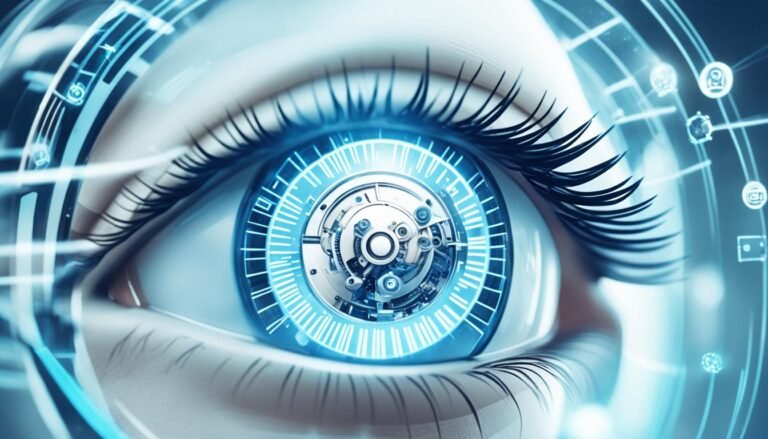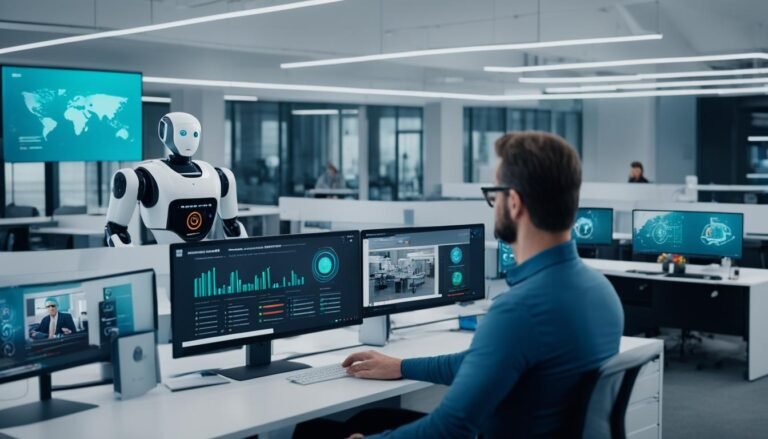Digital Literacy: Promoting understanding and responsible use of technology.
Did you know that 24% of people in the United States lack basic digital literacy skills? In today’s world, knowing how to use technology is key. It’s not just for fun; it’s vital for success in life, school, and work. Digital literacy means knowing how to use computers, stay safe online, find reliable information, and think critically.
It’s important for people to be good at using technology. This helps them move through the digital world with ease and safety. Learning these skills is a must for anyone wanting to do well in today’s digital age.
Key Takeaways:
- Digital literacy skills are essential for personal, educational, and professional success.
- 24% of people in the United States lack basic digital literacy skills.
- Digital literacy includes computer skills, online safety, information literacy, media literacy, critical thinking, and more.
- Developing digital literacy skills empowers individuals to navigate the digital landscape confidently and responsibly.
- Improving digital literacy is crucial for bridging the digital divide and ensuring digital equity.
The Importance of Digital Literacy Skills for Students
Digital literacy skills are key for students today. With more tech in schools, students need to know how to use it well. These skills help them learn better and stay safe online.
Having digital literacy skills helps students do well in school. They can use digital tools, find information online, and check if it’s true. This makes them learn more and do better in class.
These skills also keep students safe online. They learn how to protect their privacy and avoid dangers on the internet. This helps them stay safe from cyber threats.
Students with digital literacy skills can connect with others worldwide. They can talk, share ideas, and work on projects together. This helps them learn about different cultures and understand others better.
These skills also make sure everyone has the same chance to succeed. They help bridge the gap between those who have tech skills and those who don’t. This means everyone can reach their goals, no matter their background.
In short, digital literacy skills are crucial for students. They help with learning, staying safe online, connecting with others, and making sure everyone has the same chances. Schools and teachers should focus on teaching these skills to help students succeed in the digital world.
Key Components of Digital Literacy
Digital literacy covers many important skills needed to use technology well. These skills help people understand and use technology responsibly.
Technical Skills
Technical skills are the base of digital literacy. They let people use digital devices, apps, and the internet easily. Knowing how to use digital tools helps with communication and working together online.
Independent Research
Independent research skills let people find information on their own and check if it’s true. These skills help them use the internet wisely, think critically about information, and make smart choices.
Media Literacy
Media literacy teaches people to think deeply about and make media. It’s about knowing how to judge if media is trustworthy. This includes looking at text, images, audio, and video with a critical eye.
Digital Citizenship
Digital citizenship means acting right and ethically online. It’s about staying safe online, respecting others’ work, and being kind in digital spaces. Being a good digital citizen makes the internet a better place for everyone.
Communication and Collaboration
Communication and collaboration skills are key for doing well online. They help people share ideas, talk clearly, and join in online talks. Working together online with digital tools leads to new ideas and solving problems together.
Understanding and improving these digital literacy skills helps people handle the changing digital world with confidence and care.
Strategies to Promote Digital Literacy
There are many ways to boost digital literacy in schools. By using these methods, teachers help students learn how to use digital tools well. This ensures they can navigate and make the most of digital resources.
Define Learning Outcomes for Digital Literacy
It’s key to set clear goals for digital skills. This helps teachers guide students towards certain goals. These goals can include checking digital info, working well online, and using digital tools safely.
Provide Training and Support
Training and support are vital for improving digital skills. Workshops, online classes, and professional growth chances help teachers use digital tools in teaching. Students also get help through tutorials, tech support, and mentorship programs.
Incorporate Digital Resources into Teaching and Learning
Using digital tools in class is a great way to boost digital literacy. Online platforms and multimedia make learning fun and interactive. This helps students get used to digital tech and prepares them for today’s digital world.
Model Good Practices
Teachers should show how to use digital tools right. They should use them safely, protect privacy, and act ethically online. This sets a good example for students, teaching them how to be responsible online.
Encourage Reflection and Feedback
Reflection and feedback help students check their digital skills and get better. Activities like self-assessment, peer reviews, and online talks make them think about their digital habits. Feedback from teachers and peers helps them grow and learn more.
Create a Digital Culture and Community
A supportive digital culture and community is crucial for digital literacy. Teachers can make a place where students feel safe to try new things, share ideas, and learn from each other. This approach encourages students to keep exploring and learning online.
Closing the Digital Divide through Digital Literacy
The digital divide means some people don’t have the same access to or use of digital technology. Digital literacy is key to fixing this issue. It helps bridge the gap and make digital access equal for everyone.
Digital literacy means more than just using digital tools. It’s about knowing how to use them wisely. It helps people get the skills to find information, talk online, and grow personally and professionally.
Groups like governments, NGOs, and companies are working hard to fix the digital divide. Governments are giving cheap internet to those who need it and teaching digital skills. These steps help people get the tools and knowledge they need to succeed online.
The Role of Government Initiatives
Government efforts are crucial for digital inclusion. They focus on making internet affordable and accessible to all. They also fund digital skills training to help people use technology well.
NGO Efforts for Digital Inclusion
NGOs are also key in closing the digital divide. They give people technology, teach digital skills, and push for policies that help everyone get online. They work closely with communities to solve their unique digital challenges.
The One Laptop per Child program is a great example of NGO work. It gives cheap laptops to kids in poor countries. This helps kids get better education and learn more about technology.
Corporate Responsibility in Promoting Digital Literacy
Companies are also playing a big part in teaching digital skills. They work with NGOs, fund literacy programs, and bring technology to poor areas. This shows they care about making the internet available to everyone.
Together, governments, NGOs, and companies can make the internet more accessible to everyone. By working together, they help people and communities overcome the digital barriers they face.
Empowering Individuals through Digital Literacy
Digital literacy changes lives and empowers people. It helps individuals reach their goals, no matter their background. It opens a world of chances that were hard to get before.
One big way digital literacy helps is by making education available to everyone. In poor areas, not having enough resources and tools limits learning chances. But with digital skills, people can break through these limits. They can use online resources to learn and grow, even if they can’t in their local area.
Also, digital literacy helps society change for the better. It lets people join in the digital world and be heard. It helps those who are left behind share their stories and speak up. By learning digital skills, people can close the gap in access to information and online tools.
On top of social benefits, digital literacy also boosts career chances. It prepares people for the changing job market. With online courses and networking sites, they can get better at their jobs and chase their dreams.
The effect of digital literacy is huge. It can lift communities and empower people, making society more open to everyone. As we move forward in the digital era, focusing on digital literacy is key. Let’s use its power to make sure everyone has the same access to resources and chances.
Conclusion
In today’s world, knowing how to use technology is a must. It helps people use the internet and technology to their best advantage. By teaching digital skills, we can help everyone, no matter their background.
We can do this by offering training, support, and making technology available to all. This way, everyone can learn how to use technology safely and effectively. It will improve education, make online spaces safer, and give people more social chances.
Being good with technology is key to being ready for the future. As tech keeps getting better, knowing how to use it is more important than ever. By supporting digital literacy, we make sure our society is ready to succeed in the digital age.







